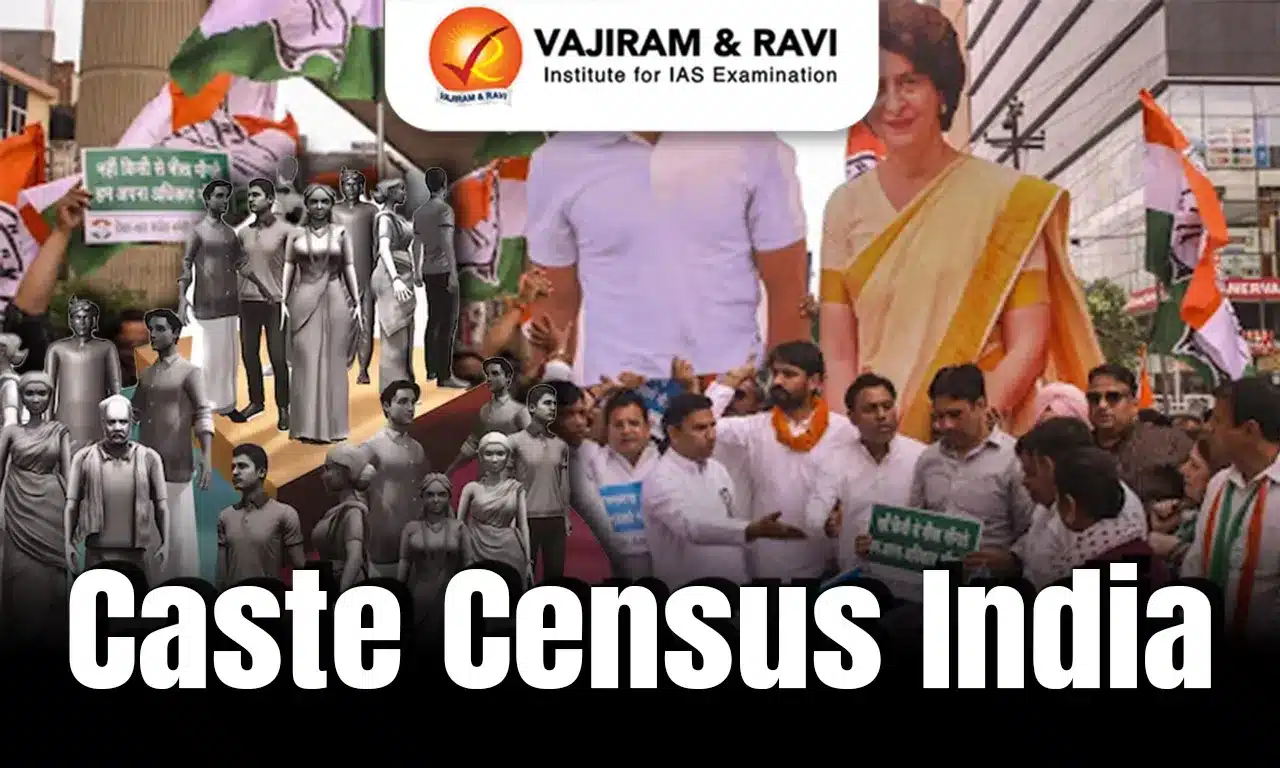What’s in Today’s Article?
- Caste Census Latest News
- Introduction
- Historical Context of Caste Enumeration
- Defining the OBC Category and Challenges in Representation
- Broader Social Implications
- Conclusion
- Caste Census India FAQs
Caste Census Latest News
- Recently, the Central Government announced that a caste enumeration will be included with the forthcoming census.
Introduction
- The Central Government’s decision to include caste enumeration in the upcoming national Census marks a pivotal moment in the country’s socio-political evolution.
- The move is not just administrative, it is deeply political.
- As debates around representation, resource allocation, and social justice intensify, the caste census is being viewed as a corrective measure to decades of skewed data and policy imbalance.
- This new phase could reshape the contours of caste-based politics and governance in India.
Historical Context of Caste Enumeration
- Caste enumeration in India began under British colonial rule with the first formal Census in 1872.
- The 1901 Census under H.H. Risley converted the exercise into a political instrument by introducing caste classification, which later influenced the formation of caste organizations and discourse across the subcontinent.
- Post-independence, caste was excluded from enumeration, barring Scheduled Castes and Scheduled Tribes.
- The assumption was that caste consciousness would fade in a democratic, egalitarian framework.
- However, this exclusion overlooked the vast diversity and socio-economic inequities among Other Backward Classes (OBCs), especially the most deprived segments.
Defining the OBC Category and Challenges in Representation
- The first attempt to identify OBCs was made through the Kaka Kalelkar Commission (1953), which listed around 2,300 communities.
- Yet, its recommendations were dismissed due to vague criteria and lack of political consensus.
- A more radical intervention came from Dr. Ram Manohar Lohia, who argued that “merit comes from opportunity,” advocating for greater access for marginalized communities.
- The breakthrough came with the Mandal Commission Report (1980), which estimated that OBCs comprised 52% of India’s population and recommended 27% reservations in public jobs and educational institutions.
- While the report’s partial implementation in 1990 changed India’s political landscape, it also exposed the limitations of relying on outdated 1931 data. Since then, the demand for a fresh caste census has gained momentum.
Broader Social Implications
- While OBCs have gained political representation over the decades, this has disproportionately benefited intermediary and dominant backward castes.
- Several smaller SC and OBC communities remain invisible in public policy and electoral equations due to lack of data, leadership, and targeted welfare.
- A caste-based census could democratize representation by bringing such groups into focus. It could also shed light on land ownership, education, and access to government schemes, revealing the economic underpinnings of caste inequalities.
- The enumeration would not only serve OBCs but also denotified tribes, nomadic communities, and underrepresented minorities.
Conclusion
The inclusion of caste enumeration in the national Census signals a paradigm shift in India’s social contract. By generating granular data on caste and correlating it with economic indicators, the state can better target welfare schemes and bridge persistent gaps in representation.
If implemented transparently and sensitively, the caste census can become a tool for inclusive development, rectifying decades of structural inequities and ensuring that no community is left behind in India’s democratic journey.
Caste Census India FAQs
Q1. When was the last caste-based Census conducted in India?
Ans. The last caste-based Census was conducted in 1931 during British rule.
Q2. What was the Mandal Commission’s estimate of the OBC population?
Ans. The Mandal Commission estimated that OBCs make up about 52% of India’s population.
Q3. Why is the caste census being demanded now?
Ans. A caste census is being demanded to update outdated data and ensure equitable policy and political representation.
Q4. Which political parties currently support caste enumeration?
Ans. Parties like Congress, Samajwadi Party, and JD(U), among others, are supporting caste enumeration as part of their electoral and social justice strategy.
Q5. How can a caste census help marginalized communities?
Ans. It can bring visibility to underrepresented groups, guide targeted welfare, and correct imbalances in political representation and resource allocation.
Source: TH
Last updated on December, 2025
→ Check out the latest UPSC Syllabus 2026 here.
→ Join Vajiram & Ravi’s Interview Guidance Programme for expert help to crack your final UPSC stage.
→ UPSC Mains Result 2025 is now out.
→ UPSC Notification 2026 is scheduled to be released on January 14, 2026.
→ UPSC Calendar 2026 is released on 15th May, 2025.
→ The UPSC Vacancy 2025 were released 1129, out of which 979 were for UPSC CSE and remaining 150 are for UPSC IFoS.
→ UPSC Prelims 2026 will be conducted on 24th May, 2026 & UPSC Mains 2026 will be conducted on 21st August 2026.
→ The UPSC Selection Process is of 3 stages-Prelims, Mains and Interview.
→ UPSC Result 2024 is released with latest UPSC Marksheet 2024. Check Now!
→ UPSC Prelims Result 2025 is out now for the CSE held on 25 May 2025.
→ UPSC Toppers List 2024 is released now. Shakti Dubey is UPSC AIR 1 2024 Topper.
→ UPSC Prelims Question Paper 2025 and Unofficial Prelims Answer Key 2025 are available now.
→ UPSC Mains Question Paper 2025 is out for Essay, GS 1, 2, 3 & GS 4.
→ UPSC Mains Indian Language Question Paper 2025 is now out.
→ UPSC Mains Optional Question Paper 2025 is now out.
→ Also check Best IAS Coaching in Delhi

















